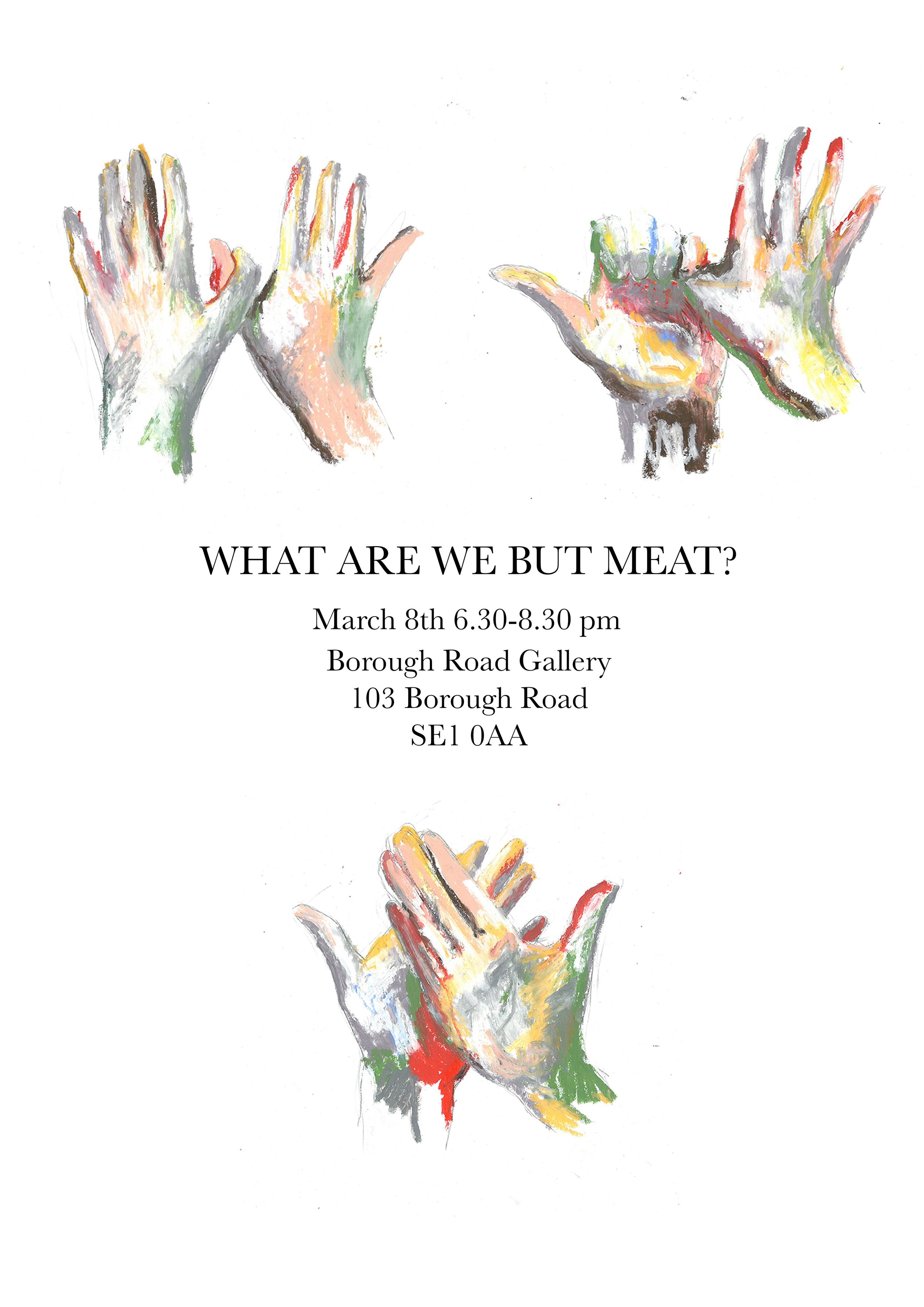This audio piece is a sample of the piece that Mattia Turchetti created for the performance at the event “What are we but meat?”. The full piece is 21 minutes long.
What are we but meat? Original posters by Cecilia Reeves /
Original posters designed by Cecilia Reeves for the performance “What are we but meat?” at the Borough Road Gallery.
Transcript of Abigail Ashford's talk "What are we bit meat?" Dorothy Mead and Donna Haraway's Cyborg Manifesto /
In this talk I am going to briefly propose some answers to the question at hand, “What are we but meat?” which was posed by Ruth Busby in her essay on Dorothy Mead’s self-portrait of 1959, questioning what is left when physical signs of humanity are stripped away in the act of painting. To do this I am going to use ideas put forward by Donna Haraway in her 1985 Cyborg Manifesto to discuss the artwork of Dorothy Mead. Part of the beauty and continued significance of these paintings lies in their visual resonance with Haraway’s vision of polyvalent identity outside patriarchal structures, involving women, machines and animals. I therefore feel that Haraway’s terminology might be used productively to describe Mead’s contribution to feminist art history, particularly in rejecting essentialism.
Read MoreWhat Modern British artist are you? /
Take our quiz to find out what Modern British artist you are.
The Bathers an animation by Cecilia Reeve with music by Red Berry /
We have commissioned contemporary artist Cecilia Reeve to respond to work in the collection. She selected the paintings of Cliff Holden as her starting point. Red Berry designed a sound piece to accompany the final animation.
Read MoreVideo of Johanna Bolton's Performance at Borough Road Gallery on Youtube /
The performance was part of Johanna Bolton’s solo exhibition “Archive: Re-imagining the Borough Road Collection” at Borough Road Gallery.
"At the time I was working on a research residency at Kew Gardens Herbarium, and had become fascinated with how scientists record and understand the botanical world through taxonomy. The way the Herbarium’s specimens were arranged physically in space was rational, but seemed to some extent random. I came out of the residency with a strong curiosity about how and why humans arrange and categorise objects to create archives.
A David Bomberg Legacy - The Sarah Rose Collection is of course a very different kind of archive, but I was curious to see how these same ideas of categorisation could function to highlight similarities and contrasts between works of art and artists. Art archives are a difficult beast, as the very nature of art is that each work is unique. This collection is knitted together by the choices of the collector, a specific location (London South Bank University, or Borough Polytechnic as it was formally known), and a precise period of time (1946 - 1951), which saw the influence of David Bomberg’s teaching begin to take shape.
I have spent my residency investigating and mapping the ordering principles that could be applied to this particular archive, first focusing on pictorial characteristics such as colour, shapes, mark making and subject matter. Through this process, I became interested in tracing human interactions between the paintings - the influence of the teacher, dynamics of rivalry and support within the group, and the shared experience of lingering trauma after the recent war."
- Johanna Bolton, about the exhibition and residency.
Images from the opening of Archive: Re-imagining the Borough Road Collection /
All images courtesy of Andreia Alves De Oliveira
The Borough at War: LSBU and Southwark, 1914-1918 /
An exhibition to mark the centenary of the Armistice, looking at the First World War through the records of LSBU and Southwark Local History Library & Archives. The exhibition includes First World War art work by David Bomberg, as well as archives from LSBU and Southwark which tell the story of the First World War through the records of students, staff and local people. Find out about how the Borough Polytechnic contributed to the war effort at home, as well as stories from those who went to fight on the Western Front and beyond. Find out more here.
War bonds demonstration c 1918 courtesy of the Southwark Archives






